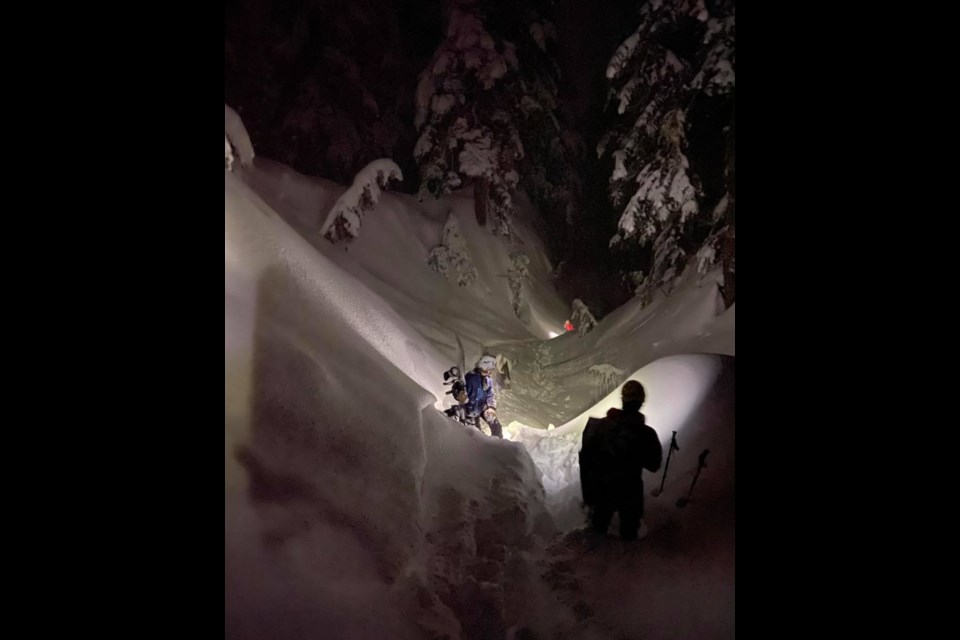North Shore Rescue teams are imploring outdoor adventurers to heed the high avalanche risk in the South Coast before heading into the backcountry.
The warning comes as the team has done two rescues in the past week in areas with high avalanche danger – one in the backcountry off Mount Strachan and one on Mount Seymour in an area known as Suicide Bluffs.
Both are avalanche prone areas, said Danks, adding the team has seen “some significant slides that are happening” recently.
“People need to check the avalanche bulletin,” he said. “It’s very timely and we have to take it seriously.”
On Monday, Avalanche Canada issued another special avalanche warning for backcountry users in both the South Coast and Vancouver Island regions, extending a previous warning to Feb. 4.
“Forecasters continue to be concerned about a buried weak layer that is generally not found in this warmer climate. The recent snowfall has now put a greater load on that layer, which means it is deeper in the snowpack,” the forecasters warned. “When this weak layer is triggered, the resulting avalanche could be deadly.”
The conditions are a particular concern because “it is not typical for this region,” said Avalanche Canada forecaster Kate Devine. “In the rugged terrain of the North Shore mountains and the popular backcountry areas of Vancouver Island, there are lots of places where this layer is a really big problem. We urge all recreational backcountry users to be extra diligent in their route finding and give yourselves a large margin for error when travelling in any type of avalanche terrain.”
The warning comes after North Shore teams rescued two teenaged snowboarders who went out of bounds on Mount Seymour Friday afternoon and quickly found themselves in waist-deep snow in avalanche terrain.
A group who were backcountry touring were making their way back to Mount Seymour Friday evening when “they heard calls for help” coming from the Suicide Bluffs area, said Danks. The group was able to pinpoint their location using a compass. Around the same time, the father of one of the teens phoned police to report the pair had not returned as planned.
Danks said the high avalanche risk complicated the rescue. An avalanche safety officer was called in to give a specific forecast for the area where the teens had become lost. “The forecast was not good,” said Danks. “It really limited what our team could do.”
“We’ll do everything we can, but we’re not going to put our members at risk of being killed by an avalanche for somebody else.”
Danks said Seymour ski patrol members went out first and made voice contact with the teens. The pair was then instructed on how to climb up to where rescuers were waiting with snowshoes to escort them to safety. The night rescue took until the early hours of Saturday morning, said Danks.
The two were “very lucky they weren’t caught in an avalanche,” and that the backcountry touring group passed by and heard their calls for help, said Danks. Sticking together and calling out to attract attention were also important, he added.
Last Tuesday night, North Shore Rescue crews rescued a seriously injured snowboarder who had been half buried in an avalanche after venturing out of bounds off Mount Strachan at Cypress Mountain Resort.
The man was alone and in dangerous terrain when the avalanche hit.
Fortunately, he was able to get a cellphone call out.
The man was hypothermic and suffering multiple injuries by the time rescuers reached him and carried him out on a stretcher.
He remains in hospital, said Danks.
The team was called out earlier in the day on Friday, to rescue an injured skier on Hollyburn Mountain whose ski binding had failed to release. Fortunately, “he was not far from the parking lot,” said Danks and team members carried him out on a stretcher.



